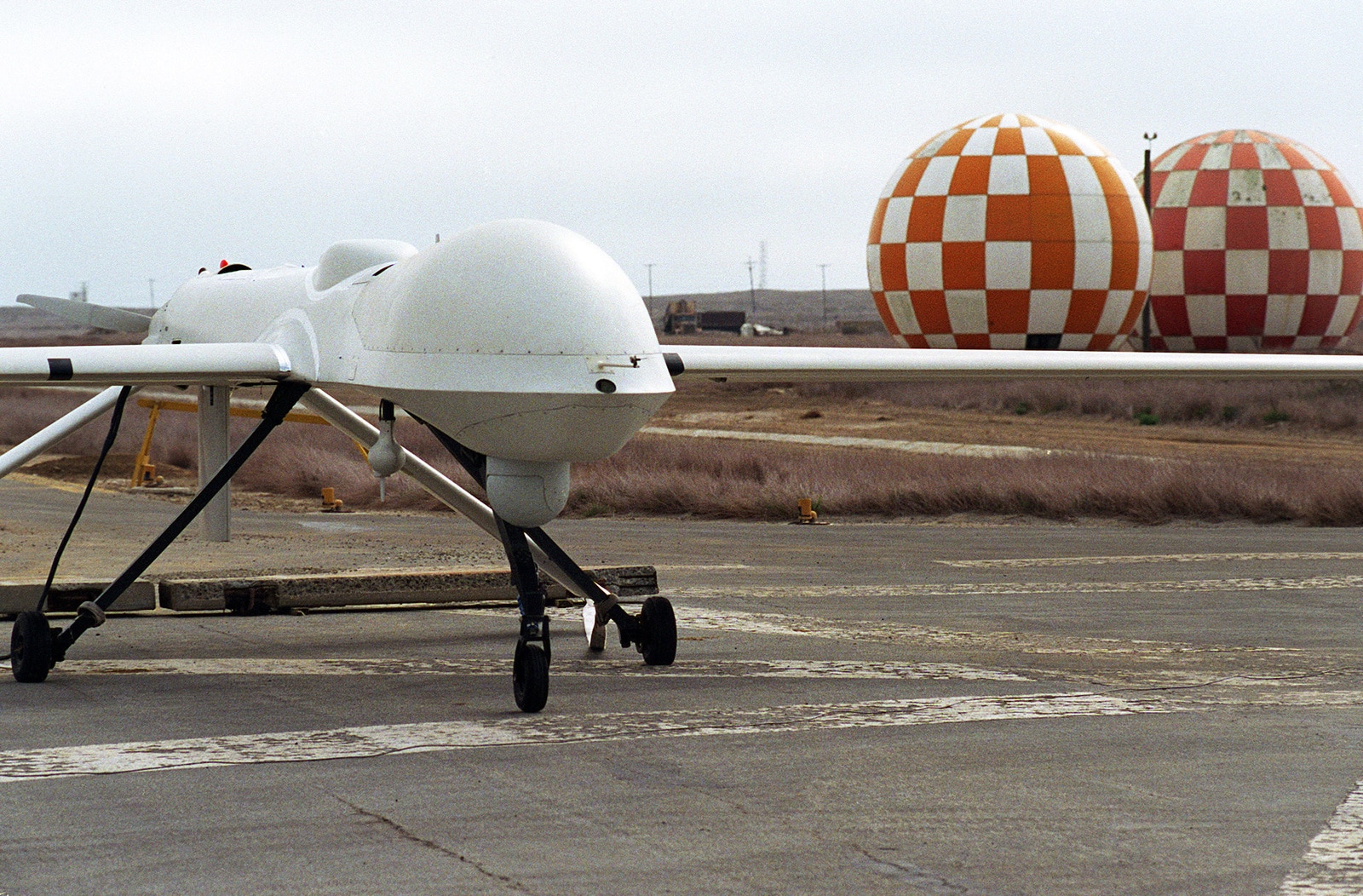Drone killing has long been billed by the military as a cleaner, smarter way to conduct war. The standard marketing line has been that with drones it is possible to neutralize even elusive enemies such as factional terrorists while sparing the lives of innocent persons, and without sacrificing any soldiers at all. The most effective propagandist throughout the period when drone assassination was redefined as “targeted killing” and normalized as a standard operating procedure was John Brennan, who served as Barack Obama’s drone killing czar before being promoted to the position of CIA director in 2013. During the eight years of the Obama presidency, many politicians were persuaded (along with the president) to support the use of lethal drones by Brennan’s duplicitous depiction of the practice of remote-control killing. Even some who claim to oppose capital punishment, such as Senator Bernie Sanders, have sung the praises of lethal drones.
That drones are more precise and discriminate implements of war, which can be used “surgically” to eliminate the “cancerous” enemy, has been the reflexive response by pundits, politicians, and the pro-military populace alike to anyone who dares to suggest that the hunting down and killing of individual human beings without indictment or trial violates the most basic principles of a democratic republic. In garnering support for remote-control killing, lethal drone advocates have capitalized on a confusing equivocation in their characterization of the targets. The victims are said posthumously to have been combatants, when in fact during the intelligence collection leading up to the strikes, they were suspects said to be potentially complicit in future possible crimes.
The stark disparity between rhetoric and reality was placed in graphic relief on August 29, 2021 by the drone strike in Kabul, Afghanistan, which killed an aid worker, Zemari Ahmadi, and nine other persons, including seven children. Immediately after the strike, the U.S. military vaunted their usual “important victory” against radical Islamist terrorists, gloating that they had protected all of those involved in the departures underway at the Kabul airport. Not only did the military insist that they had killed terrorists, when in fact 100% of the victims were nonthreatening civilians, they furthermore claimed that a secondary explosion at the site proved that the target and his entourage were planning a terrorist attack. With the aid of bomb specialists, locals on the ground were able later to determine by examining the damage created by the missile launched from the drone that there was no such secondary explosion. The military simply made up a palatable story to persuade the populace to believe that they had killed evil terrorists rather than innocent people. This was a classic case of government-composed and disseminated disinformation, which should come as no surprise to serious scholars of the Global War on Terror but was perhaps a bit disconcerting to the editors of the New York Times who promoted the Brennan smart war line for many years and thereby helped to normalize assassination.
Once the military’s initial coverage of the strike had been completely debunked, officials were forced to rewrite the secondary explosion story, eventually explaining that what had been reported as a blast from explosives in the trunk of the victim’s car was probably caused by a propane or gas tank in the vicinity. The fabrication of pleasing propaganda to propel the killing machine forward on the same old tried-and-true marketing line—that civilians are nearly never harmed by drone strikes—went on throughout the twenty-year Global War on Terror but was rarely contested loudly or effectively enough to garner any attention from the U.S. taxpayers who funded all of the carnage. How many other of the thousands of strikes claimed to be “victories” in the Global War on Terror also killed 100% civilians, as on August 29, 2021? We’ll never know, because the U.S. military exerted nearly total control over the post-strike narratives disseminated to people in the West, and dismissed alternative versions of the stories as terrorist propaganda, in some cases adding new names to their hit lists in response.
Thousands of human beings regarded as “suspicious” by their killers have been summarily executed by missiles launched from drones against targets located outside areas of active hostilities, i.e., not in war zones. In most cases, the victims were unarmed and were not apprised of the fact that they were about to be annihilated. This made it impossible for them to defend themselves against the allegation that they deserved to die for crimes which they may or may not have been going to commit at some unknown future time. The notion of pre-crime conviction of potential future criminals may evoke memories of the fictional film Minority Report, but the drone program is all too real.
If the Geneva Conventions have any meaning whatsoever, then the so-called smart warriors have been committing war crimes throughout the twenty-first century. For according even to the military itself, soldiers on the ground are not permitted to summarily execute unarmed persons who are not directly threatening anyone with death. Yet that is the essence of the vocation of a drone operator: he lays in wait far from the scene of carnage which he will unleash through the push of a button the moment his commander has decided that someone somewhere must die.
As awful as the remote-control killing of suspects is—exemplifying as it does the essence of tyranny, with the killers serving as detective, judge, jury, executioner and historians of what they themselves have done—drone enthusiasts nonetheless persist in brandishing false dichotomies to promote the practice. (Pace Tucker Carlson, false dichotomy is a fallacious form of reasoning in which two alternatives are represented as both exhaustive and exclusive.) “Carpet bombing or remote-control killing? Obviously, drones are better—more precise and less collateral damage!” This disjunction is first and foremost a piece of sophistry because in many of the places where drone strikes have been used to kill suspects, there are no soldiers on the ground to serve as the pretext for any sort of bombing whatsoever.
In countries where the U.S. government never waged war but killed thousands of people anyway, there is no conceivable scenario in which carpet bombing would have been used in the place of drones to wipe out communities where individual suspicious persons were said to hide. That would just be mass murder, tout court. In truth, the sum of all of the extrajudicial executions carried out against suspects located outside war zones, too, constitutes state-inflicted mass murder. What’s more, the people living in those areas were simultaneously terrorized by the arbitrary threat of death each time a lethal drone hovered above their heads.
We know from cases such as that of Zemari Ahmadi that civilians are not spared death but are endangered by the use of lethal drones, for the killers are human beings on the lookout for threatening persons to neutralize—that is the essence of their job. They therefore operate with a confirmation bias, interpreting as suspicious the activities of individuals already flagged as suspicious. (See Collateral Murder for a visual illustration of how such confirmation bias works.)
Disenchanted drone operators have been speaking out about the unsavory features of their profession for more than a decade now. Part of the moral rehabilitation of those who refuse to participate further in government contract killing has consisted in attempting to warn others not to make the same mistakes which they made in believing recruiters who depicted the vocation as a form of smart war, thereby flattering potential recruits while simultaneously conning them into believing that they were being offered a good deal. The profession is portrayed, first and foremost, as making it possible for soldiers to win war without getting killed or suffering injury.
Rhetoric and reality diverge here, too, because not only are innocent civilians both terrorized and killed by lethal drones, but operators themselves have suffered grave, in some cases permanent and even deadly, psychological damage through serving as government contract killers. Case in point: Air Force Captain Kevin Larson, who took his own life in a state of anguish on January 19, 2020, after having participated in 650 combat missions using the MQ-9 Reaper drone.
Despite never having themselves faced any risk of death whatsoever, remote-control killers have suffered symptoms of PTSD (post-traumatic stress disorder) at higher rates than regular combat soldiers. This is plausibly because drone killers cannot conceive of their execution of fellow human beings as literal acts of self-defense, which combatants on the ground faced with a threatening enemy are often able to do. When the choice is “kill or be killed,” even soldiers who would prefer not to kill may do so, if that is the only way to save their own life. The drone operators who have renounced their positions know, in their heart of hearts, that they were never killing in literal self-defense, and some have found that they cannot continue to act in ways which weigh so heavily on their conscience. They did not consciously sign up to serve as “government contract killers” for “the customer,” whoever that ended up being. Yet that is what the apostates eventually discovered that they had become.
Kevin Larson is no longer around to tell his story, but based on what his family and friends have disclosed, it is clear that he was plagued by the very same concerns aired by several other former drone operators and analysts over the past decade, all of whom lamented the stark disparity between the mythical depiction of remote-control killing as smart war and the reality of what it means to kill on command even in situations where it is unclear that the targets, much less other people who happen to be near them at the time, deserve to die. Among other grisly examples, Larson was ordered to kill a target and then follow and kill everyone who attended his funeral. Smart war was always too good to be true, but gullible new recruits such as Larson bought the line—until they could not anymore.
The tragic toll of ill-begotten wars on the soldiers who fight them is nothing new in history, but drone warfare is, and the claim that its perpetrators could kill without suffering negative repercussions has been exposed as a lie. Unfortunately, potential enlistees such as Kevin Larson did not hear the alarms sounded by the first group of drone program whistleblowers: Brandon Bryant, Cian Westmoreland, Daniel Hale, and others, who have done their best to attempt to warn persons like them not to be seduced by the standard marketing lines used to lure gullible young people into perpetrating crimes which they will later regret. Together these whistleblowers have revealed how the drone program administrators have redefined terms and stipulated rules of engagement which speciously portray the practice as surgically precise when it is nothing of the kind.
Daniel Hale, who currently resides in a federal penitentiary, stole and shared classified documents which confirmed, as other operators and analysts had already reported, that the exceptionally “low” rate of mistakes acknowledged publicly by the Obama administration was a result of the fact that the military-age males destroyed were defined as Enemy Killed in Action (EKIA). Any target eliminated was simply assumed to be guilty until proven innocent. This slick schema maximized the tally of “dead terrorists” reported to the populace while minimizing the possibility of any significant debate in the public sphere about the practice of so-called smart war. By inverting the burden of proof, the killers effectively (and absurdly) denied the very possibility of erroneously identifying as a terrorist any suspect in the specified age and gender cohort, most of whom, it is worth pointing out, have been persons of color. In “crowd killing” and signature strikes of entire groups of persons of unknown identity based on an assumed guilt by association, the targets executed were arguably victims of racial profiling.
Surely if more citizens understood the inherent evil being perpetrated with their tax dollars, there would be more pushback against the summary execution of suspects using lethal drones. But government-produced and mainstream media-promulgated disinformation have effectively squelched debate on the practice of remote-control killing and muted the voices of whistleblowers. Throughout the Global War on Terror, the major Western media outlets served as the functional equivalent of a Ministry of Propaganda in the tentacular military-industrial-congressional-media-academic-pharmaceutical-logistics banking complex. It should come as little surprise, then, that the drone program whistleblowers have been, at best, ignored and, at worst, discredited and criminalized.
Ominously, the Biden administration has announced the creation of a Disinformation Governance Board, to be headed up by Nina Jankowicz, a former adviser to the Ukrainian government and supporter of the current proxy war in Ukraine against Russia. Should this initiative succeed—it looks to be a violation of the First Amendment to the Constitution—we can look forward to even more suppression of dissent from pro-military narratives, which has always been depicted as conspiratorial misinformation or disinformation. This move will propel the killing machine forward as the perspectives of people on the ground and whistleblowers who attempt to reveal to taxpayers the truth and to warn future recruits about what they are being hoodwinked into doing are systematically erased. With the ongoing persecution of Julian Assange, the most effective transmitter of antiwar narratives in the first part of the twenty-first century, we are moving closer and closer to the point where what once was a democratic republic will be no more and no less than a dictatorial military state.
Critics on the right have identified the Biden administration’s formal erection of the functional equivalent of a Ministry of Truth as politically motivated, intended to provide the current office holders with the power to silence opposition to any and all official narratives. Given the reality of the war party duopoly, however, the gravest danger posed by a Disinformation Governance Board (or Ministry of Truth), to people the world over, will be its facilitation and support of the U.S. government’s hegemonic military interventions whenever and wherever the administrators please, and whoever they happen to be.
Should the elimination of citizens’ right to free speech by the government proceed, backed up by the threat of punishment, then no dissenter anywhere will be able to challenge official narratives without risking the fate suffered by U.S. citizen Anwar al-Awlaki. A formerly moderate Muslim cleric who spoke out publicly against the crimes of September 11, 2001, al-Awlaki was executed in 2011 without indictment or trial, having been put on the drone killers’ hit list when he began speaking out against the U.S. government’s own war crimes.
































